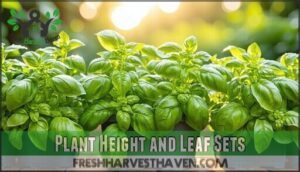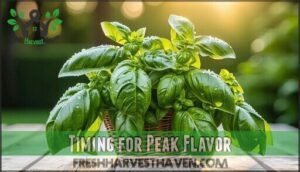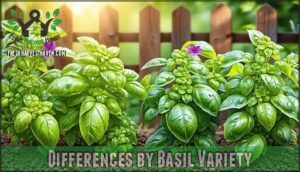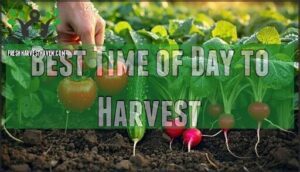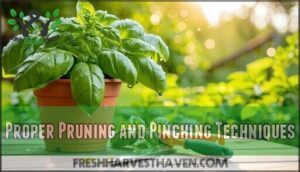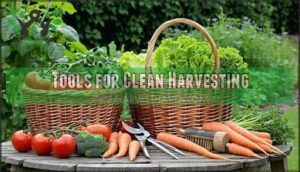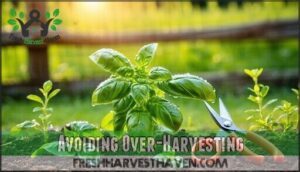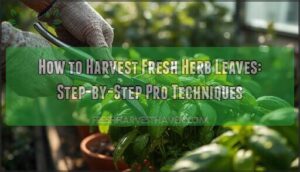This site is supported by our readers. We may earn a commission, at no cost to you, if you purchase through links.
 You’ll know when to harvest basil leaves by watching for key growth markers: plants should reach 6-8 inches tall with at least four sets of true leaves, typically 4-6 weeks after planting.
You’ll know when to harvest basil leaves by watching for key growth markers: plants should reach 6-8 inches tall with at least four sets of true leaves, typically 4-6 weeks after planting.
This sweet spot occurs just before flowering begins, when essential oils peak and leaves taste most vibrant.
Don’t wait too long—once those flower buds appear, leaf quality drops fast.
Morning harvesting captures maximum flavor intensity, while regular pruning every 1-2 weeks keeps plants producing bushy, flavorful growth all season long.
The timing dance between plant maturity and peak flavor holds secrets that separate ordinary gardeners from basil masters.
Table Of Contents
- Key Takeaways
- How Basil Grows and Matures
- When to Harvest Basil Leaves
- Signs Your Basil is Ready to Pick
- Best Time of Day to Harvest
- How to Harvest Basil for Continued Growth
- What Happens if You Don’t Harvest
- Storing and Preserving Fresh Basil
- Frequently Asked Questions (FAQs)
- How do you harvest Basil?
- How to prick off basil leaves for harvesting?
- When to harvest Basil?
- How tall should a basil plant be before harvesting?
- How do you know when basil is ready to harvest?
- How do you know when to cut basil leaves?
- When should you not eat basil leaves?
- Is it better to dry or freeze basil leaves?
- Can basil leaves be harvested during heavy rain?
- Are there specific pests to check for pre-harvest?
- Conclusion
Key Takeaways
- Harvest when your basil reaches 6-8 inches tall with at least four sets of mature leaves – this typically happens 4-6 weeks after planting and signals peak essential oil concentration.
- Pick your basil in early morning after the dew dries but before temperatures climb above 85°F to capture maximum flavor intensity and preserve those volatile compounds.
- Cut stems just above leaf nodes (where two leaves meet the main stem) using clean scissors, and never harvest more than one-third of the plant’s height to ensure healthy regrowth.
- Harvest regularly every 1-2 weeks and pinch off any flower buds immediately – once your basil starts flowering, the leaves become bitter and production drops dramatically.
How Basil Grows and Matures
Understanding how basil develops from seedling to mature plant helps you time your harvest perfectly for maximum flavor and continued production.
Most basil varieties follow predictable growth patterns, reaching harvestable size at 6-8 inches tall with at least four sets of true leaves, typically occurring 4-6 weeks after planting when environmental conditions support steady vegetative growth.
This understanding is crucial for achieving the best flavor, as it allows for the optimal timing of harvest, ensuring maximum flavor and continued production.
Popular Basil Varieties and Their Traits
You’ll discover that basil varieties offer distinct leaf flavors and growth habits worth mastering.
Sweet Basil reaches 12-24 inches with large, cupped leaves perfect for pesto.
Thai Basil stays compact at 12-18 inches, delivering spicy, anise-like notes.
Lemon Basil grows taller with citrusy undertones, while Purple Basil adds ornamental appeal with milder, clove-like flavors.
Holy Basil develops fuzzy leaves rich in beneficial compounds, and overall, basil varieties like Sweet Basil offer a range of flavors and growth habits.
Growth Stages of Basil Plants
Your basil plants follow predictable basil growth stages from seed germination through plant maturation.
During the first weeks, root growth establishes while early leaf formation creates the first true leaves.
As stem development progresses, you’ll notice basil leaf growth accelerating with new nodes appearing regularly.
Understanding these growing basil leaves phases helps time your pruning basil leaves and basil leaf harvesting techniques perfectly for maximum yield.
Environmental Needs for Healthy Basil
Your basil plant care success hinges on meeting specific environmental requirements.
Well-drained soil quality with organic amendments creates the foundation for robust basil leaf growth.
These heat-loving plants demand full sun exposure (6-8 hours daily) and temperature control above 70°F during the day.
Proper water needs and humidity levels guarantee healthy foliage development before pruning basil leaves begins, which is crucial for the overall plant care success.
When to Harvest Basil Leaves

Perfect basil care starts with understanding harvest timing—the key to revealing maximum flavor and ensuring continuous leaf production.
You’ll want to begin harvesting basil leaves when your plants reach 6-8 inches tall with at least four sets of mature leaves.
This typically occurs 35-45 days after planting, depending on variety and growing conditions.
The sweet spot for when to pick basil lies just before flowering begins.
Once flower buds appear, redirect that energy back into leaf production by pinching them off immediately.
This simple regrowth tip extends your harvest window substantially.
For prime flavor optimization, harvest during early morning hours after dew has dried.
The essential oils responsible for basil’s distinctive aroma concentrate overnight, making morning the prime time for harvesting basil leaves.
Regular pruning every 1-2 weeks maintains leaf quality while encouraging bushier growth patterns that maximize your overall yield throughout the growing season.
Signs Your Basil is Ready to Pick
You’ll know your basil is ready to pick when it reaches several key developmental milestones that signal prime leaf quality and flavor concentration.
The most reliable indicators include specific plant height measurements, leaf maturity characteristics, and variety-specific timing cues that guarantee you harvest at peak essential oil content, which is crucial for flavor concentration.
Plant Height and Leaf Sets
You’ll know your basil is ready when it reaches 6-8 inches tall with at least four leaf sets. This basil height signals proper plant maturity for your first basil leaf harvest.
Key indicators for harvesting basil:
- Stem Length: Main stems show 4-6 inches of growth above soil level
- Node Development: Multiple branching points visible along the stem structure
- Leaf Growth: Each node displays paired leaves in healthy green coloration
- Plant Maturity: Strong root system supports vigorous above-ground development
Most varieties reach this basil harvest time 4-6 weeks after planting. When to pick basil depends on achieving this ideal size rather than rushing early harvests. Proper basil leaf pruning at this stage encourages bushier growth patterns.
Leaf Appearance and Color
Healthy basil leaves display vibrant green hue with firm leaf texture and smooth surfaces.
Look for consistent color variations across the plant—pale or yellowing leaves indicate stress. Fresh leaves show distinct leaf patterns with pronounced veins and glossy appearance.
These visual cues signal ideal basil leaf harvest timing. Avoid wilted, spotted, or discolored foliage when harvesting basil for best results, and prioritize leaves with a glossy appearance.
Timing for Peak Flavor
Why wait when your basil’s flavor peaks just before flowering?
Essential oil concentration reaches maximum levels during this sweet spot, typically when plants hit 6-8 inches tall with four leaf sets.
Harvest timing directly impacts flavor profiles – early morning captures peak oil concentration after dew evaporates.
This strategic approach maximizes taste while supporting robust regrowth strategies for continuous harvesting basil throughout peak season, ensuring peak season productivity.
Differences by Basil Variety
Different basil varieties reach peak harvesting readiness at distinct stages, requiring personalized approaches for ideal flavor profiles.
Sweet basil delivers maximum essential oils at 6-8 weeks, while Thai basil thrives when harvested at 12-18 inches before purple flowers emerge.
Purple varieties need 8-10 inches for anthocyanin concentration, and lemon basil peaks earlier at 10 inches to preserve citral content that creates its signature aroma.
Best Time of Day to Harvest
The ideal harvesting window occurs during early morning hours when essential oil concentrations reach their peak levels in basil leaves.
Temperature and humidity conditions during this timeframe preserve the volatile compounds that give basil its distinctive aroma and flavor profile.
Morning Vs. Afternoon Harvesting
You’ll achieve peak leaf quality and oil retention by harvesting basil early morning after dew dries.
Morning temperatures preserve essential oils that dissipate in afternoon heat. This harvesting basil timing maximizes flavor compounds and supports healthy regrowth patterns.
Afternoon picking reduces oil concentration, affecting taste quality. Following proper basil care tips means choosing cooler morning hours for optimal pruning basil sessions and growing basil leaves successfully.
Understanding the best harvest timing strategies is vital for maintaining prime flavor and texture in leafy greens like basil, and this is crucial for successful harvesting.
Effects of Temperature and Humidity
Temperature control and humidity levels dramatically shape your harvesting basil success.
Temperature and humidity control during harvest can make or break your basil’s essential oil content
Heat stress kicks in when temperatures soar above 90°F, reducing essential oil concentration in leaves.
Climate impact becomes obvious during scorching afternoons—volatile compounds literally evaporate.
Weather effects matter most during harvest windows.
Optimal conditions sit between 70-85°F with 70-85% humidity for growing basil leaves and sustainable basil harvest timing.
Understanding the basil humidity effects is vital for maintaining healthy plants and recognizing the importance of heat stress and climate impact.
Maximizing Essential Oil Content
Essential oils reach peak concentration when basil plants experience slight moisture stress before harvesting basil.
You’ll maximize oil concentration by picking leaves early morning after dew evaporates but before temperatures climb.
This harvest timing preserves volatile compounds that enhance flavor and guarantees superior leaf quality.
Heat dissipates these precious oils, reducing your basil leaf yield’s potency and compromising sustainable basil harvest practices for ideal regrowth techniques, which is crucial for superior leaf quality.
How to Harvest Basil for Continued Growth
Harvesting basil correctly guarantees your plants keep producing fresh leaves throughout the growing season. You’ll need to use proper techniques that encourage new growth while maintaining plant health.
Proper Pruning and Pinching Techniques
Mastering proper pruning techniques transforms your basil plants into leafy powerhouses.
Pinch the central stem just above leaf pairs to trigger explosive branching – this doubles your harvest potential. Make clean cuts quarter-inch above nodes using sharp scissors.
Start pinching when plants reach six inches tall, then repeat every two weeks. Never strip more than one-third of foliage at once.
To maximize flavor, consider the basil growth stages when planning your harvest schedule.
Tools for Clean Harvesting
Clean harvesting tools prevent disease transmission between plants while ensuring precise cuts that promote healthy regrowth. Your basil’s future depends on proper sanitation.
Using proper sterilized equipment is essential for maintaining plant health.
- Sterilized Scissors – Wipe blades with rubbing alcohol between plants to prevent bacterial spread
- Pruning Shears – Choose bypass-style clippers for clean cuts without crushing delicate stems
- Harvest Knives – Sharp, thin blades work best for precise harvesting of individual leaves
- Gardening Gloves – Protect hands while maintaining grip on clean clippers during extended pruning sessions
Leaving Enough Growth for Regrowth
Your basil plant needs strategic pruning methods to thrive. When harvesting basil, always cut stems just above leaf nodes—these junction points where new growth emerges.
Never remove more than one-third of your plant’s total height, as this stress hampers regrowth techniques. Effective basil care involves using proper pruning tool sets to make clean cuts.
| What to Leave | What to Cut |
|---|---|
| Bottom leaf nodes intact | Stems above nodes only |
| At least 4-6 leaf sets | Top flowering portions |
| Strong main stems | Weak, damaged growth |
| 2/3 of plant height | Maximum 1/3 height |
Proper stem cutting guarantees your basil plant maintenance succeeds. Focus on leaf node management—these growing points contain the plant’s regenerative power. Smart harvest timing means your growing basil keeps producing fresh leaves all season long, ensuring continuous production and a healthy plant.
Avoiding Over-Harvesting
You can’t just grab handfuls of leaves and expect your basil plant to thrive like some magical herb garden.
Proper yield management requires restraint to prevent plant stress and maintain healthy leaf regrowth.
- Never remove more than one-third of the plant’s total height during harvesting basil sessions
- Wait 1-2 weeks between major harvests to allow adequate leaf production recovery time
- Focus regrowth techniques on cutting stems above leaf nodes rather than stripping individual leaves
- Monitor your basil plant maintenance schedule to avoid consecutive heavy harvesting periods
- Practice harvest timing patience—your plant needs energy reserves for sustained basil leaf production
What Happens if You Don’t Harvest
When you skip regular harvesting, your basil plants will naturally progress to their reproductive phase and begin flowering.
This flowering process, called bolting, fundamentally changes the plant’s energy allocation from producing flavorful leaves to developing seeds, resulting in bitter-tasting foliage and substantially reduced leaf production.
Flowering and Bolting Risks
When flowers appear on your basil plants, you’re witnessing the beginning of the end for quality leaf production.
Flowering triggers bolting, causing rapid plant stress and inevitable leaf drop.
Those delicate white or purple basil flowers might look pretty, but they’re signaling your plant to stop producing tender leaves and focus on seed production instead.
Without proper flower control and bolting prevention, your basil leaf cultivation efforts become futile as essential oils concentrate in reproductive parts rather than foliage.
Impact on Leaf Quality and Yield
Ignoring harvest windows sabotages your basil’s potential, transforming tender leaves into tough, bitter disappointments.
When you skip regular harvesting basil sessions, three critical problems emerge:
- Leaf Quality deteriorates as leaves become coarse and lose aromatic intensity
- Yield Factors shift toward flower production instead of fresh foliage
- Flavor Optimization plummets due to reduced essential oil concentration
Proper harvest timing and regrowth strategies prevent these basil gardening setbacks.
Plant Lifespan and Productivity
Without regular harvesting, your basil plant’s lifespan dramatically shortens.
Most varieties lose vigor after 12 weeks when left unharvested, triggering natural aging around 70 days.
This neglect disrupts normal harvest cycles, reducing plant productivity by limiting leaf regrowth potential.
Proper plant care through consistent harvesting maintains basil longevity and supports healthy growth patterns throughout the growing season.
Understanding harvesting techniques is essential for maximizing crop yields and quality, which are crucial for a successful harvest, and healthy growth.
Storing and Preserving Fresh Basil
Once you’ve harvested your basil at the perfect time, proper storage becomes essential for maintaining those precious essential oils and vibrant flavor.
You’ll want to act quickly since fresh basil leaves are delicate and can deteriorate within hours if not handled correctly, which makes proper storage crucial.
Short-Term Storage Methods
Fresh basil stays crisp for several days with proper Cool Storage techniques.
Wrap stems in damp paper towels, then place in plastic bags with airflow holes for ideal Moist Control.
Store in your refrigerator’s crisper drawer at 40°F.
For counter storage, treat basil like cut flowers—trim stems and place in water.
Change water daily to maintain freshness.
These Herb Preservation methods keep your fresh basil vibrant until you’re ready for cooking adventures.
To maintain freshness over longer periods, consider using proper storage containers to keep your basil fresh.
Drying, Freezing, and Other Techniques
Beyond short-term storage, you can extend your basil’s life through various dehydration methods.
Drying basil works best using shade techniques, which preserve 15-30% more essential oils than sun drying.
Freezing basil maintains flavor when chopped and stored in ice cubes.
Oil infusion captures aromatic compounds perfectly.
Herb preservation through freeze drying offers professional results, while spice blending transforms fresh basil leaves into custom seasonings for year-round enjoyment.
To maximize flavor and aroma, understanding herb drying methods is vital for effective preservation.
Shelf Life and Maintaining Freshness
Properly stored fresh basil maintains peak quality for 7-10 days when you keep cut stems in water like fresh flowers.
Refrigerated leaves wrapped in damp paper towels last 5-7 days.
Food safety requires checking for dark spots or slimy texture before use.
Fresh storage beats dried alternatives for maximum flavor retention in your herb shelf preservation methods.
Creative Uses for Leftover Basil
Transforming excess basil into culinary treasures maximizes your harvest investment while preventing waste.
These creative applications extend your homegrown herbs’ utility beyond simple garnishing.
- Basil Tea – Steep fresh or dried leaves for aromatic herbal infusions
- Pesto Sauce – Blend with nuts, cheese, and oil for freezing pesto portions
- Basil Oil – Infuse olive oil with basil leaf tips for drizzling
- Herb Butter – Mix chopped basil into softened butter for bread spreads
- Frozen Cubes – Preserve basil in ice cube trays with water or oil
Frequently Asked Questions (FAQs)
How do you harvest Basil?
Most basil plants yield 3-5 cuttings per season when harvested correctly.
Cut stems ¼ inch above leaf nodes using clean scissors when plants reach 6-8 inches tall with four leaf sets, preferably in early morning for peak essential oils.
How to prick off basil leaves for harvesting?
Pinch stems just above leaf nodes using clean fingers or scissors.
Cut ¼-inch above where two leaves meet the main stem.
This encourages bushier regrowth while preventing plant stress and disease transmission.
When to harvest Basil?
Absolutely crush your harvest timing!
You’ll achieve peak flavor when plants reach 6-8 inches tall with four leaf sets.
Harvest early morning after dew dries, before flowering begins, for maximum essential oil concentration and ideal taste.
How tall should a basil plant be before harvesting?
Your basil plant should reach 6-8 inches tall with at least four sets of leaves before you start harvesting.
This height guarantees the plant’s established enough to handle regular cutting and bounce back with vigorous new growth, ensuring it can support regular harvesting and maintain its health.
How do you know when basil is ready to harvest?
You’ll know your basil’s ready when it reaches 6-8 inches tall with at least four sets of healthy, vibrant green leaves, typically 4-6 weeks after planting or transplanting outdoors.
How do you know when to cut basil leaves?
Like a gardener’s green light, you’ll know it’s cutting time when your basil reaches 6-8 inches tall with at least four sets of leaves, before flowering begins for maximum flavor.
When should you not eat basil leaves?
You shouldn’t eat basil leaves when they’re yellow, wilted, damaged, or infested with pests. Also avoid consuming leaves after they’ve flowered, as they’ll taste bitter and have reduced flavor quality.
Is it better to dry or freeze basil leaves?
Freezing preserves basil’s vibrant essence like capturing summer in ice, while drying concentrates flavors but sacrifices that garden-fresh punch you’re craving for your culinary creations.
Can basil leaves be harvested during heavy rain?
You shouldn’t harvest basil during heavy rain since wet leaves lose essential oils, develop poor flavor, and increase disease risk. Wait until foliage dries completely for superior quality.
Are there specific pests to check for pre-harvest?
Check your basil plants for aphids, spider mites, whiteflies, and leaf miners before harvesting.
These tiny troublemakers love tender leaves and can quickly turn your perfect harvest into a pest-ridden disappointment.
Conclusion
Mastering when to harvest basil leaves transforms your garden from average to extraordinary.
You’ve learned the precise timing markers – that critical 6-8 inch height, four leaf sets, and pre-flowering window when essential oils peak.
Morning harvests capture maximum flavor intensity, while proper pruning techniques guarantee continuous production throughout the growing season.
Regular harvesting every 1-2 weeks prevents flowering and maintains leaf quality.
With these botanical principles guiding your decisions, you’ll consistently harvest basil at its flavor pinnacle, elevating every culinary creation, by applying the right harvesting techniques and understanding the importance of essential oils.
- https://www.gorillagrowtent.com/blogs/news/how-to-harvest-basil
- https://www.clickandgrow.com/blogs/news/the-no-nonsense-guide-to-harvesting-basil
- https://kellogggarden.com/blog/gardening/herb-gardening/tips-and-tricks-for-harvesting-basil-and-other-herbs/
- https://www.attainable-sustainable.net/harvesting-basil/
- https://www.creativevegetablegardener.com/how-to-preserve-basil/

